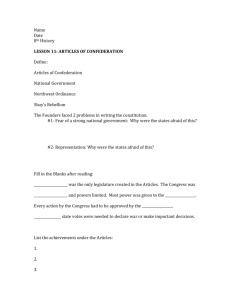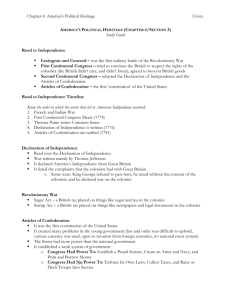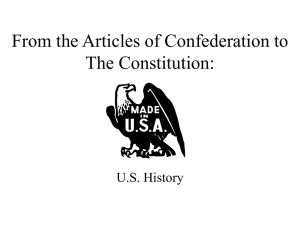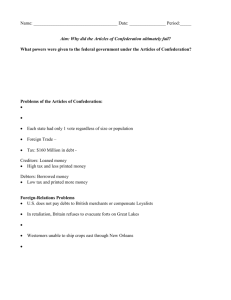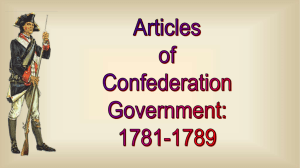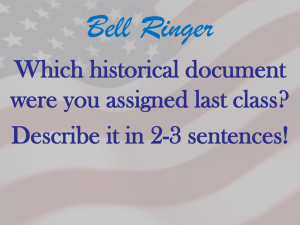Ch4 Sec 3 Moving Toward Nationhood
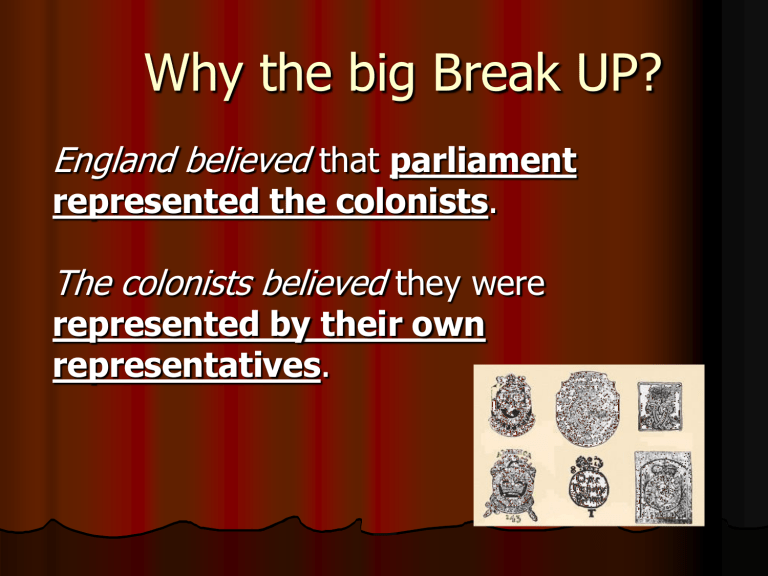
Why the big Break UP?
England believed that parliament
represented the colonists.
The colonists believed they were represented by their own
representatives.
No Taxation without Representation!
To make people pay taxes, England gave the governor’s greater power. People were thrown
in jail for not paying taxes.
The Cry went out…
A United Front
Colonists decided they needed a united
response to Parliament’s threats.
1
st
Continental Congress
In 1774 delegates from 12 colonies met in Philadelphia for the First Continental
Congress.
To pressure England, they pledged to cut off all trade
with England.
They agreed to meet again in
a year if the situation did not improve.
One year later…..
By the time the
Second Continental
Congress met in
1775, in
Massachusetts were already fighting
English soldiers.
Give Me Liberty or Give Me Death!
Patrick Henry, argued for
independence. He stated, that there was no turning back now.
COMMON SENSE
In 1776, Thomas
Paine wrote and published COMMON
SENSE.
He said England belongs to Europe and America to itself.
The Declaration of Independence
The members of the Second Continental
Congress voted for independence and appointed a committee to write the Declaration Of
Independence.
Committee Members
Ben Franklin, Thomas Jefferson, and John Adams.
Jefferson was asked to do the actual writing.
Natural Rights
John Locke’s influence
“We hold these truths to be self-evident, that all men
are created equal, that they are endowed by their Creator with certain
unalienable Rights that among these are Life,
Liberty, and the pursuit
of Happiness.” -
Office of the Citizen
The people give their power to the
government as long as it protects their rights.
To secure these rights, Governments are instituted among Men, deriving their just powers from the consent of the Governed.”
If the government abuses this power – they the people may change it.
“Whenever any form of government becomes destructive of these ends, it is the
Right of the People to alter or to abolish it, and to institute new Government.”
The Declaration is adopted
This Declaration of Independence was adopted in
Philadelphia on July 4, 1776.
It proclaimed that “ these colonies are, and of
Right ought to be Free and Independent States.”
New Government
Now that the colonies were free and
independent states, they had to organize their own government.
A COMPACT is a written agreement to make and obey the laws for the welfare of the
group.
State Constitutions
Each state
created a
CONSTITUTION – government . or plan of
included rights for citizens, limits of the government power, and to protect against tyranny – the # of years a governor could hold office.
Montesquieu
Each state also used
MONTESQUIEU’s idea of separating powers into three
branches. Legislature was given the most power because it most directly represented interests of the
citizens.
Articles of Confederation
A plan was drawn up for an alliance of independent states in 1777. This compact, known as THE ARTICLES OF CONFEDERATION
Under the Articles of Confederation
There would be no executive or judicial
branches of national government under the Articles of Confederation.
The national legislature – known as
CONGRESS – was given power to
declare war, make treaties, and work out trade agreement between states.
Articles of Confederation
No power to tax or enforce laws – this power was only given to states.
It needed RATIFICATION (approval) before it could go into effect.
All 13 states had to approve the plan.
It took 4 years before the Articles of
Confederation was ratified in 1781.
THE LIMPING GOVERNMENT
The Revolutionary
War was won by
General George
Washington and his troops. However, the government had new challenges to face.
Debt & Trade
The colonies had borrowed
money to buy war supplies to fight for independence.
Congress could not regulate trade.
England would not allow
Americans to trade in the
British West Indies.
Farmers in Debt
Many farmers slid into debt – because they couldn’t sell their crops. In addition – to try and pay the war debts, states had raised taxes.
Farmers unable to pay taxes, or sell their goods – faced losing their farms.
Courts threatened to sell their farms to raise money to pay their taxes.
Shays’ Rebellion
In 1786, angry MA farmers led by a former war hero
DANIEL SHAYS, stormed into the courthouse to disrupt business.
Shays’ Rebellion
Congress didn’t have power to force other states to help put down the uprising because there was not a strong central government.
MA had to use it’s own state militia to crush the rebellion.
Stronger Government
Many called for a stronger national government that could keep law and order and solve the economic problems that led to Shays Rebellion.

